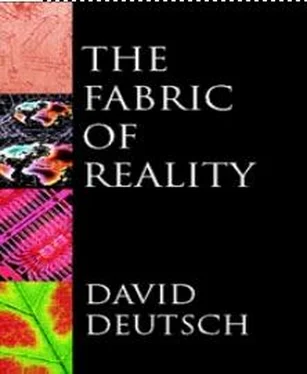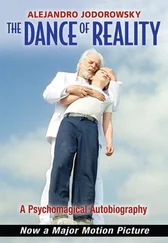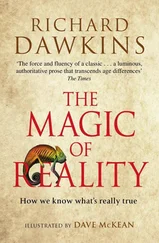David Deutch - The Fabric of Reality
Здесь есть возможность читать онлайн «David Deutch - The Fabric of Reality» весь текст электронной книги совершенно бесплатно (целиком полную версию без сокращений). В некоторых случаях можно слушать аудио, скачать через торрент в формате fb2 и присутствует краткое содержание. ISBN: , Жанр: Физика, Философия, на английском языке. Описание произведения, (предисловие) а так же отзывы посетителей доступны на портале библиотеки ЛибКат.
- Название:The Fabric of Reality
- Автор:
- Жанр:
- Год:неизвестен
- ISBN:0-7139-9061-9
- Рейтинг книги:4 / 5. Голосов: 2
-
Избранное:Добавить в избранное
- Отзывы:
-
Ваша оценка:
- 80
- 1
- 2
- 3
- 4
- 5
The Fabric of Reality: краткое содержание, описание и аннотация
Предлагаем к чтению аннотацию, описание, краткое содержание или предисловие (зависит от того, что написал сам автор книги «The Fabric of Reality»). Если вы не нашли необходимую информацию о книге — напишите в комментариях, мы постараемся отыскать её.
The Fabric of Reality — читать онлайн бесплатно полную книгу (весь текст) целиком
Ниже представлен текст книги, разбитый по страницам. Система сохранения места последней прочитанной страницы, позволяет с удобством читать онлайн бесплатно книгу «The Fabric of Reality», без необходимости каждый раз заново искать на чём Вы остановились. Поставьте закладку, и сможете в любой момент перейти на страницу, на которой закончили чтение.
Интервал:
Закладка:
Single-particle interference experiments such as I have been describing show us that the multiverse exists and that it contains many counterparts of each particle in the tangible universe. To reach the further conclusion that the multiverse is roughly partitioned into parallel universes, we must consider interference phenomena involving more than one tangible particle. The simplest way of doing this is to ask, by way of a ‘thought experiment’, what must be happening at the microscopic level when shadow photons strike an opaque object. They are stopped, of course: we know that because interference ceases when an opaque barrier is placed in the paths of shadow photons. But why? What stops them? We can rule out the straightforward answer — that they are absorbed, like tangible photons would be, by the tangible atoms in the barrier. For one thing, we know that shadow photons do not interact with tangible atoms. For another, we can verify by measuring the atoms in the barrier (or more precisely, by replacing the barrier by a detector) that they neither absorb energy nor change their state in any way unless they are struck by tangible photons. Shadow photons have no effect.
To put that another way, shadow photons and tangible photons are affected in identical ways when they reach a given barrier, but the barrier itself is not identically affected by the two types of photon. In fact, as far as we can tell, it is not affected by shadow photons at all. That is indeed the defining property of shadow photons, for if any material were observably affected by them, that material could be used as a shadow-photon detector and the entire phenomenon of shadows and interference would not be as I have described it.
Hence there is some sort of shadow barrier at the same location as the tangible barrier. It takes no great leap of imagination to conclude that this shadow barrier is made up of the shadow atoms that we already know must be present as counterparts of the tangible atoms in the barrier. There are very many of them present for each tangible atom. Indeed, the total density of shadow atoms in even the lightest fog would be more than sufficient to stop a tank, let alone a photon, if they could all affect it. Since we find that partially transparent barriers have the same degree of transparency for shadow photons as for tangible ones, it follows that not all the shadow atoms in the path of a particular shadow photon can be involved in blocking its passage. Each shadow photon encounters much the same sort of barrier as its tangible counterpart does, a barrier consisting of only a tiny proportion of all the shadow atoms that are present.
For the same reason, each shadow atom in the barrier can be interacting with only a small proportion of the other shadow atoms in its vicinity, and the ones it does interact with form a barrier much like the tangible one. And so on. All matter, and all physical processes, have this structure. If the tangible barrier is the frog’s retina, then there must be many shadow retinas, each capable of stopping only one of the shadow-counterparts of each photon. Each shadow retina only interacts strongly with the corresponding shadow photons, and with the corresponding shadow frog, and so on. In other words, particles are grouped into parallel universes. They are ‘parallel’ in the sense that within each universe particles interact with each other just as they do in the tangible universe, but each universe affects the others only weakly, through interference phenomena.
Thus we have reached the conclusion of the chain of reasoning that begins with strangely shaped shadows and ends with parallel universes. Each step takes the form of noting that the behaviour of objects that we observe can be explained only if there are unobserved objects present, and if those unobserved objects have certain properties. The heart of the argument is that single-particle interference phenomena unequivocally rule out the possibility that the tangible universe around us is all that exists. There is no disputing the fact that such interference phenomena occur. Yet the existence of the multiverse is still a minority view among physicists. Why?
The answer, I regret to say, does not reflect well upon the majority. I shall have more to say about this in Chapter 13, but for the moment let me point out that the arguments I have presented in this chapter are compelling only to those who seek explanations. Those who are satisfied with mere prediction, and who have no strong desire to understand how the predicted outcomes of experiments come about, may if they wish simply deny the existence of anything other than what I have been calling ‘tangible’ entities. Some people, such as instrumentalists and positivists, take this line as a matter of philosophical principle. I have already said what I think of such principles, and why. Other people just don’t want to think about it. After all, it is such a large conclusion, and such a disturbing one on first hearing. But I think that those people are making a mistake. As I hope to persuade readers who bear with me, understanding the multiverse is a precondition for understanding reality as best we can. Nor is this said in a spirit of grim determination to seek the truth no matter how unpalatable it may be (though I hope I would take that attitude if it came to it). It is, on the contrary, because the resulting world-view is so much more integrated, and makes more sense in so many ways, than any previous world-view, and certainly more than the cynical pragmatism which too often nowadays serves as a surrogate for a world-view among scientists.
‘Why can’t we just say,’ some pragmatic physicists ask, ‘that photons behave as if they were interacting with invisible entities? Why can we not leave it at that? Why do we have to go on to take a position about whether those invisible entities are really there?’ A more exotic variant of what is essentially the same idea is the following. ‘A tangible photon is real; a shadow photon is merely a way in which the real photon could possibly have behaved, but did not. Thus quantum theory is about the interaction of the real with the possible .’ This, at least, sounds suitably profound. But unfortunately the people who take either of these views — including some eminent scientists who ought to know better — invariably lapse into mumbo-jumbo at that point. So let us keep cool heads. The key fact is that a real, tangible photon behaves differently according to what paths are open, elsewhere in the apparatus, for something to travel along and eventually intercept the tangible photon. Something does travel along those paths, and to refuse to call it ‘real’ is merely to play with words. ‘The possible’ cannot interact with the real: non-existent entities cannot deflect real ones from their paths. If a photon is deflected, it must have been deflected by something, and I have called that thing a ‘shadow photon’. Giving it a name does not make it real, but it cannot be true that an actual event, such as the arrival and detection of a tangible photon, is caused by an imaginary event such as what that photon ‘could have done’ but did not do. It is only what really happens that can cause other things really to happen. If the complex motions of the shadow photons in an interference experiment were mere possibilities that did not in fact take place, then the interference phenomena we see would not, in fact, take place.
The reason why interference effects are usually so weak and hard to detect can be found in the quantum-mechanical laws that govern them. Two particular implications of those laws are relevant. First, every subatomic particle has counterparts in other universes, and is interfered with only by those counterparts. It is not directly affected by any other particles in those universes. Therefore interference is observed only in special situations where the paths of a particle and its shadow counterparts separate and then reconverge (as when a photon and shadow photon are heading towards the same point on the screen). Even the timing must be right: if one of the two paths involves a delay, the interference is reduced or prevented. Second, the detection of interference between any two universes requires an interaction to take place between all the particles whose positions and other attributes are not identical in the two universes. In practice this means that interference is strong enough to be detected only between universes that are very alike. For example, in all the experiments I have described, the interfering universes differ only in the position of one photon. If a photon affects other particles in its travels, and in particular if it is observed, then those particles or the observer will also become differentiated in different universes. If so, subsequent interference involving that photon will be undetectable in practice because the requisite interaction between all the affected particles is too complicated to arrange. I must mention here that the standard phrase for describing this fact, namely ‘observation destroys interference’, is very misleading in three ways. First, it suggests some sort of psychokinetic effect of the conscious ‘observer’ on basic physical phenomena, though there is no such effect. Second, the interference is not ‘destroyed’: it is just (much!) harder to observe because doing so involves controlling the precise behaviour of many more particles. And third, it is not just ‘observation’, but any effect of the photon on its surroundings that depends on which path the photon has taken, that does this. For the benefit of readers who may have seen other accounts of quantum physics, I must briefly make contact between the argument I have given in this chapter and the way the subject is usually presented. Perhaps because the debate began among theoretical physicists, the traditional starting-point has been quantum theory itself. One states the theory as carefully as possible, and then one tries to understand what it tells us about reality. That is the only possible approach if one wants to understand the finer details of quantum phenomena. But as regards the issue of whether reality consists of one universe or many, it is an unnecessarily complicated approach. That is why I have not followed it in this chapter. I have not even stated any of the postulates of quantum theory — I have merely described some physical phenomena and drawn inescapable conclusions. But if one does start from theory, there are two things that everyone agrees on. The first is that quantum theory is unrivalled in its ability to predict the outcomes of experiments, even if one blindly uses its equations without worrying much about what they mean. The second is that quantum theory tells us something new and bizarre about the nature of reality. The dispute is only about what exactly this is. The physicist Hugh Everett was the first to understand clearly (in 1957, some thirty years after the theory became the basis of subatomic physics) that quantum theory describes a multiverse. Ever since, the argument has raged about whether the theory admits of any other interpretation (or re-interpretation, or reformulation, or modification, etc.) in which it describes a single universe, but continues correctly to predict the outcomes of experiments. In other words, does accepting the predictions of quantum theory force us to accept the existence of parallel universes?
Читать дальшеИнтервал:
Закладка:
Похожие книги на «The Fabric of Reality»
Представляем Вашему вниманию похожие книги на «The Fabric of Reality» списком для выбора. Мы отобрали схожую по названию и смыслу литературу в надежде предоставить читателям больше вариантов отыскать новые, интересные, ещё непрочитанные произведения.
Обсуждение, отзывы о книге «The Fabric of Reality» и просто собственные мнения читателей. Оставьте ваши комментарии, напишите, что Вы думаете о произведении, его смысле или главных героях. Укажите что конкретно понравилось, а что нет, и почему Вы так считаете.












